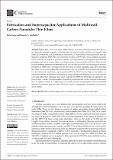Fabrication and Supercapacitor Applications of Multiwall Carbon Nanotube Thin Films
Author(s)
Jiang, Kyle; Gerhardt, Rosario A.
Downloadcarbon-07-00070.pdf (6.194Mb)
Publisher with Creative Commons License
Publisher with Creative Commons License
Creative Commons Attribution
Terms of use
Metadata
Show full item recordAbstract
Multiwalled carbon nanotubes (MWCNTs) are a one-dimensional nanomaterial with several desirable material properties, including high mechanical tensile modulus and strength, high electrical conductivity, and good thermal conductivity. A wide variety of techniques have been optimized to synthesize MWCNTs and to fabricate thin films of MWCNTs. These synthesis and fabrication methods vary based on precursor materials, process parameters, and physical and chemical principals, and have a strong influence on the properties of the nanotubes and films. Thus, the fabrication methods determine the performance of devices that can exploit the advantageous material properties of MWCNTs. Techniques for the fabrication of carbon nanotubes and carbon nanotube thin films are reviewed, followed by a discussion of the use of MWCNTs as an electrode material for electrochemical double-layer supercapacitors (EDLCs). EDLCs feature high power density, excellent reversibility and lifetime, and improved energy density over electrolytic capacitors. Beyond surveying fabrication techniques previously explored for MWCNT electrodes, an alternative approach based on inkjet printing capable of depositing a small amount of active material is discussed. Such an approach allows for a high degree of control over electrode properties and can potentially reduce cost and active material waste, which are essential components to the gradual conversion to green energy.
Date issued
2021-09-30Department
Massachusetts Institute of Technology. Department of Mechanical EngineeringPublisher
Multidisciplinary Digital Publishing Institute
Citation
C 7 (4): 70 (2021)
Version: Final published version